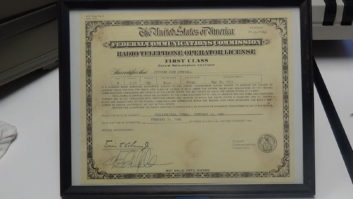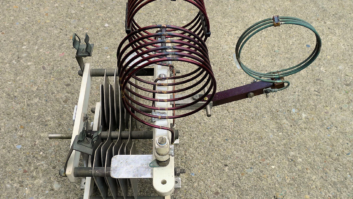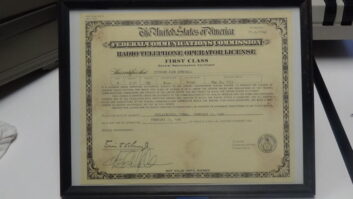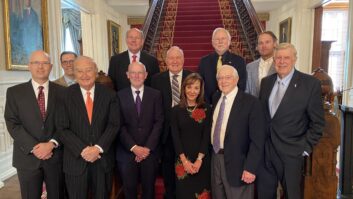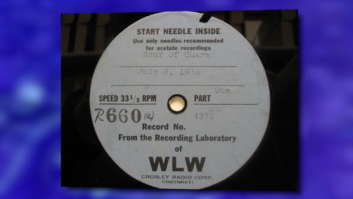
Studio of WTMJ(AM) with Kent Aschenbrenner at right. L.A.’s a great town, but the local definition of “history” there would seem to consist of “whatever hasn’t been torn down yet and replaced with a strip mall.” So for our sophomore outing, how about a look at a market where the history is alive and well – albeit with a healthy respect for the state of the art, too?
Radio City
That would be Milwaukee, Wis., a city that I’d heard lots of good things about long before I finally pull into town one sunny Wednesday afternoon in August 2005.
The first destination on the agenda is also probably the most historically important broadcasting facility in town: “Radio City,” the venerable headquarters of Journal Broadcast Group, WTMJ(AM), WKTI(FM) and WTMJ(TV).

WTMJ lobby mural A relatively bland facade and an unfortunate portico installed in the late ’80s now obscure the classic Art Deco lines that made the building an instant Milwaukee landmark when it opened its doors in 1941.
WTMJ was one ambitious regional broadcaster back then. Its AM station was already a dominant voice, and it had been experimenting with television for over a decade at its facilities in the Milwaukee Journal building downtown.
Despite the “Radio City” name, the building was designed from the start for both radio and TV, though the interruption of World War II would keep commercial TV from signing on there until 1947, when WTMJ took to the air as Wisconsin’s first TV station.

Exterior view of WTMJ’s ‘Radio City’ I head inside the building with Kent Aschenbrenner, Journal’s regional director of engineering. The Deco legacy is much more easily spotted, from the murals that line all four walls of the lobby to the tile hallways that lead back through the original building, which was constructed around a large audience studio for WTMJ radio.

The venerable 1250 (former WEMP) transmitter building and towers. That space is now occupied by studios for WTMJ(AM) and WKTI(FM), with big glass windows looking out into the halls, but Kent is happy to show a fellow history buff some of the corners upstairs that once served as viewing galleries for the original auditorium studio, as well as the storage room in a back corner of the building that was once the studio for WTMJ’s early FM operations. (The station was a pioneer on that band as well; as early as 1942, it had a 50 kW low-band FM signal on the air from a standalone transmitter site in Richfield, Wisconsin.)
The “Radio City” building added a distinctive feature during a renovation in 1967: a “TV studio in the round,” with prominent windows facing the front lawn and busy East Capitol Drive outside. That exterior detail was also obscured in the 1989 renovation, which added office space at the front of the building that’s now the Journal Broadcast Group corporate headquarters, but the round studio is still there, home to WTMJ(TV)’s newscasts.

Entercom Milwaukee Chief Engineer Chris Tarr with his RCA BTA-5T backup transmitter. Music in the glow
WTMJ’s Radio City is hardly the only historic site to be seen in Milwaukee. Over on the western edge of town, Clear Channel’s six-station cluster sits at the base of the five-tower WOKY (920) array, and just a few miles away in Hales Corner, Entercom’s three stations occupy a modern building next to the five towers of what’s now WSSP (1250), the station long known as WEMP.
It’s not the modern building that grabs my attention here, though. Across the parking lot, Chief Engineer Chris Tarr unlocks the door to the other building on the property. This Art Deco gem still houses the transmitters for WSSP and sister station WMYX (99.1), including a lovely old RCA. It has seen a lot of history along the way.

Tubes aglow in an RCA BTA-5T. The 1250 facility was WMAW when it signed on out here after World War II with a seven-tower array, but soon changed calls to WCAN. Station owner Lou Poller soon embarked on a quixotic adventure in early UHF television, running a CBS affiliate on Channel 25 for several years before CBS itself entered the market on a rival UHF facility. That didn’t last long either, as the late ’50s brought several new VHF stations to town. And after fighting CBS in court, Poller ended up selling the 1250 license to the owners of WEMP, which had been operating as a 250-watt signal on 1340. More on that in a moment.
Aside from the transmitters for 1250 and 99.1, the old WMAW-WCAN-WEMP-WSSP building is used mainly for storage now, but Chris has some big plans to change that. Somewhere on his long-term “to do” list is a project to clear out the building’s main room, a high-ceilinged space that’s ringed by the glassed-in transmitter rooms.

The main room in the old WEMP transmitter building, someday to be a performance studio. If all goes well, this space will eventually be used as a live performance space for Entercom’s two FMs here, WMYX and WXSS (103.7), with bands playing in the glow of the RCA tubes.
Time capsule
From the Entercom facility, Clear Channel’s Kent Winrich leads our little group south to Racine County and his big AM gun.
WISN(AM) began as a regional signal on 1150, but then it upgraded in the ’50s to 50 kilowatts day, 10 kilowatts night on 1130. That’s a crowded channel in the upper Midwest, with big signals from Detroit, Milwaukee and Minneapolis all using tight directional patterns to aim their power north after sunset.
In WISN’s case, that means nine towers, which make a striking sight as dusk falls.

The night phasor network for WISN(AM)’s nine-tower array. Before it gets completely dark, though, there’s one more big AM site to see down here. A decade ago, WTMJ(AM) left its longtime transmitter site in Brookfield, west of Milwaukee, and built a new six-tower array in Racine County. Taking advantage of the rules change that removed the 5 kW power limit on the former “regional” channels, WTMJ became the first of those stations to boost day power to 50 kW, sending a commanding signal over most of eastern Wisconsin. (It runs 10 kW at night.)
So what about that 1340 facility? After WEMP moved to 1250, new owners turned 1340 into WRIT, a screaming top-40 rocker. The old WRIT building and self-supporting tower still stand on Milwaukee’s west side. Many additions and renovations later, it’s now home to Saga’s cluster of five stations.

One of the nine tower bases of WISN. 1340 now programs black gospel as WJYI, and the cluster also includes a rare commercial classical station, WFMR(FM), which makes for a pleasant diversion from the usual fare elsewhere on the dial.
The WRIT calls, meanwhile, landed on the FM dial a few years back, on what’s now a Clear Channel oldies station at 95.7. Its studios are now with the rest of the Clear Channel cluster out at the WOKY site, but its transmitter remains at the former studio site on West Capitol Drive, just a mile or so from WTMJ’s “Radio City.”
In its own way, the WRIT site is as much a broadcasting time capsule as Radio City. When the new studios were ready, the staff just picked up and left. So today, the old WRIT studios sit quiet and dark as an inadvertently-preserved relic of radio just before the computer age, carts in the rack, carpet on the walls and rotary-pot boards patiently waiting for another screaming jock to talk up the hits.

WISN(AM)’s nine tower array. There are many more Milwaukee pictures, and a curious diversion into the city’s unusual early TV history, in my Tower Site of the Week archives at www.fybush.com/siteindex.html.
Frequent RW contributor Scott Fybush is always on the lookout for interesting “Travels with Scott” destinations. Contact him at [email protected].
Share your thoughts on Milwaukee radio history and facilities. Write [email protected].






